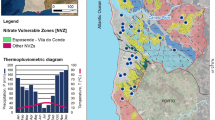Abstract
Process based semi-analytical models for surface and ground water management of a recharge basin, based on the concept of managed aquifer recharge (MAR) and aquifer storage treatment and recovery (ASTR), are presented. The model for simulation of aquifer responses due to recharge and extraction of recharged water is developed by integrating the hydrologic components into basic water balance equation; and the models for simulation of contaminants’ fate in the recharge basin and through the soil column beneath are developed by considering: (i) in-basin mass balance with decay of contaminant and, (ii) 1-dimensional advection-dispersion-decay equation coupled with linearized sorption isotherm equation, respectively. The estimate of hydrologic components included: inflow to the recharge basin from its catchment by SCS-CN model, water surface evaporation by combination of Priestley-Taylor and Penman method, recharge by Hantush’s analytical equation for water table rise due to recharge from a rectangular spreading basin in absence of pumping well, and drawdown due to pumping by Theis’s well function equation. The contaminant’s fate estimate included: time varying changes in concentration due to assimilation and detention of contaminant in the recharge basin and transport of assimilated materials through saturated soil column until they reached the groundwater table. The performances of recharge-pumping and contaminants’ transport models are illustrated by examples. These models can successfully be used and upscale as potential tools for MAR and ASTR.





Similar content being viewed by others
References
Biswas AK (2004) Integrated water resources management: A reassessment: A water forum contribution. Water Int 29(2):248–256 https://www.adb.org/Documents/Books/AWDO/2007/dp05.pdf
Central Ground Water Board (CGWB) (1996) National perspective plan for recharge to groundwater by utilizing surplus monsoon runoff. Ministry of Water Resources, Govt. of India, New Delhi
Central Ground Water Board (CGWB) (2002) Master plan for artificial recharge to ground water in India. Ministry of Water Resources, Govt. of India, New Delhi 117p
Central Ground Water Board (CGWB) (2007) Mannual on artificial recharge to ground water, Ministry of Water Resources. Govt. of India, New Delhi 185p
Central Ground Water Board (CGWB) (2013) Master plan for artificial recharge to ground water in India. Ministry of Water Resources, Govt. of India, New Delhi 208p
De Bruin HAR (1978) A Simple Model for Shallow Lake Evaporation. J Appl Meteorol 17(8):1132–1134
Dillon PJ (2005) Future management of aquifer recharge. Hydrogeol J 13(1):313–316
Dillon PJ, Pavelic P, Page D, Beringen H, Ward J (2009) Managed aquifer recharge: An Introduction, Waterlins Report Series No. 13. National Water Commission, Canberra, 37p
Ghosh NC, Kumar S, Grützmacher G, Ahmed S, Singh S, Sprenger C, Singh RP, Das B, Arora T (2015) Semi-analytical model for estimation of unsteady seepage from a large water body influenced by variable flows. J Water Resour Manag, Springer 29(9):3111–3129
GWP (Global Water Partnership) and the International Network of Basin Organizations(INBO) (2009) A handbook for integrated water resources management in basins. ISBN : 978-91-85321-72-8, 103p. https://www.gwpforum.org
GWP (Global Water Partnership), Technical Advisory Committee (TAC) (2000) Integrated water resources management, TAC background paper no. 4. GWP, Stockholm https://www.gwptoolbox.org/images/stories/gwplibrary/background/tac_4_english.pdf
Hantush MS (1967) Growth and decay of groundwater mounds in response to uniform percolation. Water Resour Res 3:227–234
Konikow LF, Kendy E (2005) Hydrogeol J 13:317. https://doi.org/10.1007/s10040-004-0411-8
Laio F, Tamea S, Ridolfi L, D’Odorico P, Rodriguez-Iturbe I (2009) Ecohydrology of groundwater-dependent ecosystems: 1. Stochastic water table dynamics. Water Resour Res 45:W05419. https://doi.org/10.1029/2008WR007292
Mishra SK, Singh VP (1999) Another look at SCS-CN method. J Hydrol Eng ASCE 4(3):257–264
Mukherji A, Shah T (2005) Hydrogeol J 13:328. https://doi.org/10.1007/s10040-005-0434-9
Ogata A, Bank RB (1961) A solution of differential equation of longitudinal dispersion in porous media. U S Geol Surv Prof Pap 411:A1–A7
Priestley CHB, Taylor RJ (1972) On the assessment of surface heat flux and evaporation using large scale parameters. Mon Weather Rev 100:81–92
Pumo D, Tamea S, Noto LV, Miralles-Wilhelm F, Rodriguez-Iturbe I (2010) Modelling below-ground water table fluctuations in the Everglades. Water Resour Res 46(11):W11557. https://doi.org/10.1029/2009WR008911
SAPH PANI (2012) Report on existing MAR practice and experience in India, especially in Chennai, Maheshwaram, Raipur. Project supported by the European Commission within the Seventh Framework Programme Grant agreement No. 282911. 86p
SCS (1993) National Engineering Handbook, Section 4: Hydrology, Soil Conservation Service, USDA, Washington, D.C.
Theis C (1935) The relation between the lowering of the piezometric surface and the rate and duration of discharge of a well using groundwater storage. Trans Am Geophys Union 16:519–524
UNESCO (2009) Integrated Water Resources Management in Action : Dialogue Paper. The United Nations Educational, Scientific and Cultural Organization Publications, ISBN: 978-92-3-104114.3, 18p
Victoria EPA (2009) Guidelines for Managed Aquifer Recharge (MAR)-health and environmental risk management. Publication 1290:21p
Author information
Authors and Affiliations
Corresponding author
Ethics declarations
Conflict of Interest
None.
Rights and permissions
About this article
Cite this article
Gurjar, S., Ghosh, N.C., Kumar, S. et al. Process Based Integrated Models for Managed Aquifer Recharge and Aquifer Storage Treatment and Recovery. Water Resour Manage 33, 387–400 (2019). https://doi.org/10.1007/s11269-018-2108-0
Received:
Accepted:
Published:
Issue Date:
DOI: https://doi.org/10.1007/s11269-018-2108-0




